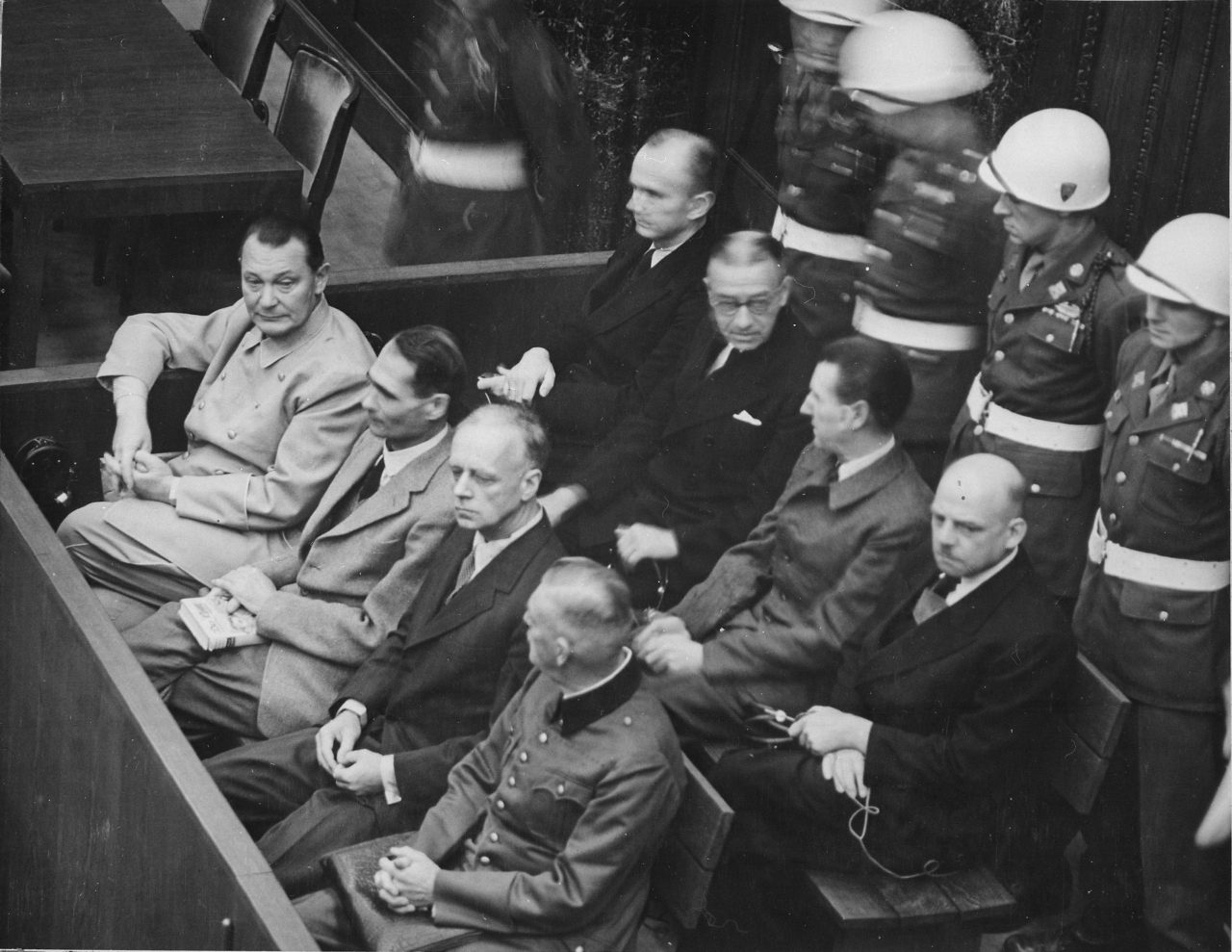Reflecting on Nuremberg’s legacy, 75 years on
After the end of the Second World War, Nazi leaders were tried in Nuremberg, Germany. Now, 75 years on, Holocaust Memorial Day Trust's Claudia Hyde offers her reflections on the tribunals' legacy.

Image: Nazi leaders put on trial at the end of the Second World War included Adolf Hitler’s designated successor, Herman Goering, far left.
That four great nations, flushed with victory and stung with injury stay the hand of vengeance and voluntarily submit their captive enemies to the judgment of the law is one of the most significant tributes that Power has ever paid to Reason.
Justice Robert Jackson
It is hard to overstate the legacy of the Nuremberg Trials.
The International Military Tribunal (IMT) at Nuremberg was established following a contentious round of negotiations between the Allied Powers, who sought to settle the question of how to punish Germany’s leaders for its crimes. Launched in November 1945, the IMT was tasked with trying the most senior Nazi leaders with crimes against humanity and ‘crimes against the peace’.

Claudia Hyde, HMDT’s Local Government HMD Officer
It formed the foundation for modern international justice, from the former Yugoslavia (the ICTY) to Cambodia (the ECCC). The IMT enshrined the notion that individuals must be held accountable for their participation in atrocities – no matter their rank – and this has been an enduring principle of international law ever since.
However, just as significant as Nuremberg’s accomplishments were what it did not achieve. As the crime of genocide had not yet been established, the IMT did not actually prosecute Nazi leaders for the Holocaust. The key concern for the Allies was reaffirming their victory by punishing Germany for its aggression, and it is telling that no survivors of the Holocaust or of Nazi persecution were invited to provide their testimonies.
Their testimonies were not seen as an important part of the IMT’s work, reflecting the idea that the tribunal was more for the benefit of the Allies than for those who were most devastated by the Nazi’s atrocities. As a result, mentions of the atrocities committed against Jewish people in the IMT’s judgments are sparse, and there are no mentions of the other victims of Nazi persecution.
By alienating those who were directly impacted by the worst of Nazi crimes, it could be argued that Nuremberg built an account of World War II that was incomplete. Justice cannot be secured without truth, and for survivors, the judgments at Nuremberg were not the whole truth.
Despite these failures, Nuremberg was undoubtedly a seismic shift in the law, but the international justice project lost momentum in the coming decades. It was not until the international community was confronted with overwhelming evidence of the atrocities in Bosnia in 1993 that the international criminal law project was revived. Since then, international and hybrid tribunals have been established across the world, culminating in the founding of the International Criminal Court.
The efficacy of these institutions is the subject of much debate. Since Nuremberg, only a handful of senior military commanders and heads of state have been tried for the crime of genocide. Moreover, it is far from clear that international criminal law has a deterrent effect on perpetrators.
The ICTY, for instance, was established in 1993 and had already begun its work when the genocidal massacre in Srebrenica took place. The failure of the international community to prevent the genocide still leaves a deep and painful scar on Bosnians. The ICC has also been criticised by nations in the Global South who point out that it has, so far, only convicted African war criminals, ignoring crimes committed at the hands of wealthier and more powerful nations.
All of this revolves around one question: what does justice look like? Is it lasting peace in a country emerging from conflict? Is it found in the satisfaction that comes from seeing a perpetrator pronounced guilty? Or is it finally finding out the truth about what happened to you, your friends and your family, and why?
Fundamentally, justice means different things to different people and no transitional justice mechanism will ever fully satisfy everyone. In the negotiations that led to the establishment of the IMT, the US delegation initially favoured summary executions of hundreds of Nazi officials and members over a trial.
The government of Cambodia fought to restrict the mandate of the ECCC so that it did not cover atrocities committed before the Khmer Rouge came to power. Much controversy has surrounded the ICTY’s failure to investigate war crimes committed by Croatian forces.
During the Nuremberg trials, US Prosecutor Benjamin Ferencz said of the Nazis: ‘Death was their tool, and life their toy. If these men be immune, then law has lost its meaning and man must live in fear.’ The past 75 years, however, have shown us that the reality is quite different.
Justice in the face of atrocities is a product of compromises between principles and pragmatic considerations, where the needs and desires of different actors are weighed up against each other. As long as wars continue to be fought, the struggle for justice too will endure.
Claudia Hyde is HMDT’s Local Government HMD Officer and holds a degree in Law from the London School of Economics, with a specialism in international human rights law.